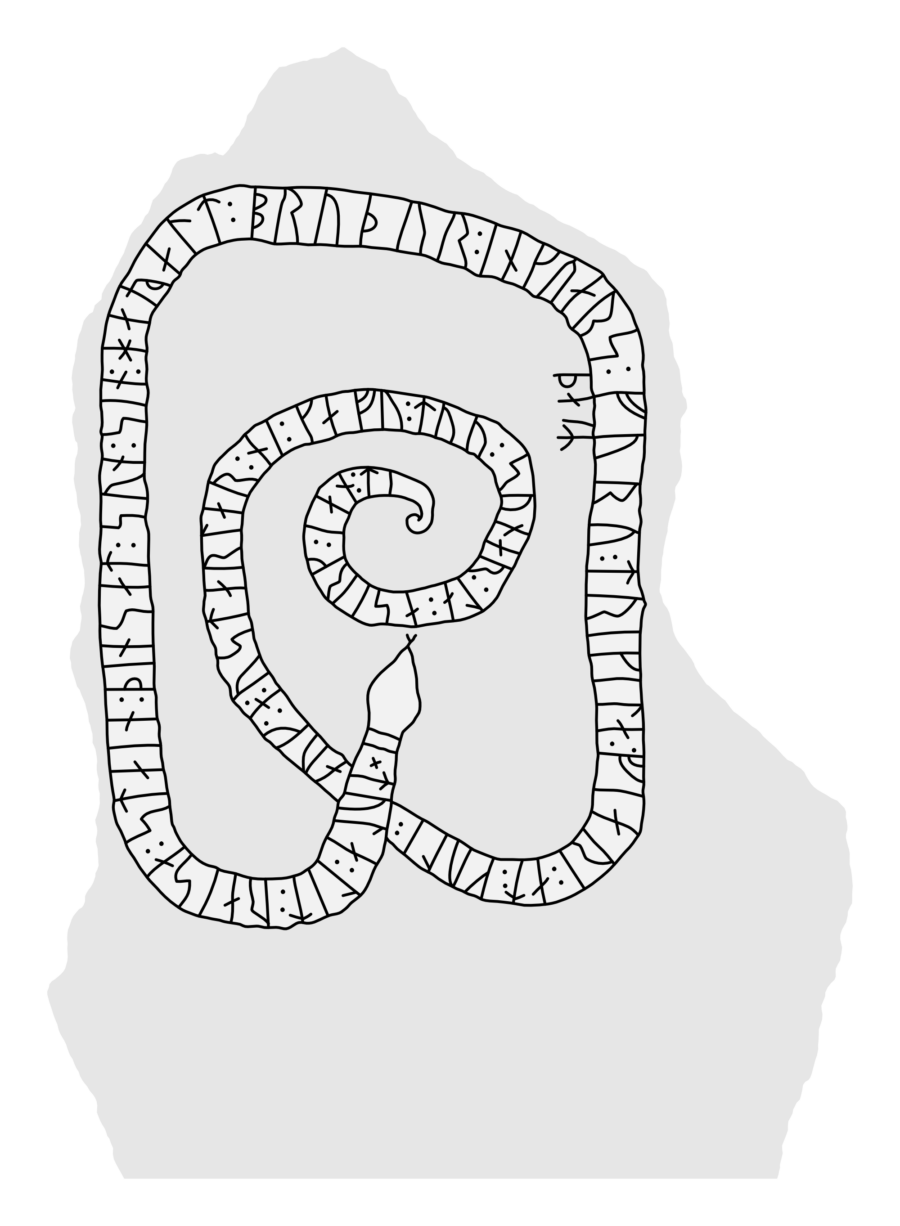
The Gripsholm Stone Sö 179
January 23, 2020
The carvings of the stone are in the runestone style B-e-v (c. 1010-1050) pertaining to the Ringerike style and contemporary with Pr 1 and Pr 2.
The inscription is not signed.
The granite stone is c. 2 m tall and 1,05 m wide (across the tail of the serpent).
Runic inscription
The first part of the rune text begins at the head end of the serpent. The second part is a single word positioned outside of the rune ribbon at the top right corner of the stone. The third part continues where the first part ended.
Runes
[1] × ᛏᚢᛚᛅ ᛬ ᛚᛁᛏ ᛬ ᚱᛅᛁᛋᛅ ᛬ ᛋᛏᛅᛁᚾ ᛬ ᚦᛁᚾᛋᛅ| |ᛅᛏ ᛬ ᛋᚢᚾ ᛬ ᛋᛁᚾ ᛬ ᚼᛅᚱᛅᛚᛏ ᛬ ᛒᚱᚢᚦᚢᚱ ᛬ ᛁᚾᚴᚢᛅᚱᛋ ᛬ [2] ᚦᛅᛁᛦ [3] ᚠᚢᚱᚢ ᛬ ᛏᚱᛁᚴᛁᛚᛅ ᛬ ᚠᛁᛅᚱᛁ ᛬ ᛅᛏ ᛬ ᚴᚢᛚᛁ ᛬ ᛅᚢᚴ ᛬ ᛅ᛬ᚢᛋᛏᛅᚱᛚᛅ| |ᛅᚱ᛬ᚾᛁ ᛬ ᚴᛅᚠᚢ ᛬ ᛏᚢᚢ ᛬ ᛋᚢᚾᛅᚱ᛬ᛚᛅ ᛬ ᛅ ᛋᛁᚱᚴ᛬ᛚᛅᚾ᛬ᛏᛁ
Transliteration
× tula : lit : raisa : stain : þinsa| |at : sun : sin : haralt : bruþur : inkuars : þaiʀ furu : trikila : fiari : at : kuli : auk : a:ustarla| |ar:ni : kafu : tuu : sunar:la : a sirk:lan:ti
Old Norse
Tola let ræisa stæin þennsa at sun sinn Harald, broður Ingvars.
ÞæiR foru drængila
fiarri at gulli
ok austarla
ærni gafu,
dou sunnarla
a Særklandi.
English
Tóla had this stone raised in memory of her son Haraldr, Ingvarr’s brother.
They travelled valiantly
far for gold,
and in the east
gave (food) to the eagle.
(They) died in the south
in Serkland.
Notes
In plain English the inscription tells us that Harald travelled far away as part of Ingvar’s legendary viking expedition with the objective to get rich. In Russia they fought enemies in battle and won. But they ultimately died further south in what is probably the land of the Saracen i.e. the Arab area around and between the Black Sea and the Caspian Sea.
Sö 179 is one of c. 30 so-called Ingvar Runestones commemorating those who died following Ingvar the Far-Travelled on a viking expedition going far down the eastern trade routes of Europe.
Learn more about Ingvar and his fatal viking expedition here: The Ingvar Expedition
It is not clear why Tóla only had the stone raised in memory of Harald and not in memory of both brothers. One possibility could be that Harald and Ingvar was only brothers-in-arm or blood brothers and not biological brothers. A second possibility could be that the two men were only half-brothers and Tóla was only the mother of Harald. And finally a third possibility could be that Ingvar was commemorated by Tóla on a second stone, which is now lost.
The second half of the inscription is in alliterative verse of the form fornyrðislag.
The phrase to feed the eagle is a kenning, i.e. a poetic synonym, which means ‘to kill enemies and leave them on the battlefield for the eagles to feed on’.
———
Gripsholm, Södermanland, Sweden
Sö 179